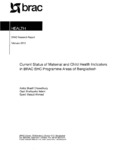| dc.contributor.author | Chowdhury, Anita Sharif | |
| dc.contributor.author | Islam, Qazi Shafayetul | |
| dc.contributor.author | Ahmed, Syed Masud | |
| dc.date.accessioned | 2019-12-03T05:18:52Z | |
| dc.date.available | 2019-12-03T05:18:52Z | |
| dc.date.issued | 2013-02 | |
| dc.identifier.citation | Chowdhury, A. S., lslam, Q. S., & Ahmed, S. M. (2013, February). Current status of maternal and child health indicators in BRAC EHC Programme areas of Bangladesh. Research Reports (2013): Health Studies, Vol - XLV, 117–148. | en_US |
| dc.identifier.uri | http://hdl.handle.net/10361/13175 | |
| dc.description.abstract | Essential Health Programme (EHC) is one of many development efforts of BRAC
providing an integrated package of preventive, promotive and basic curative services at
a minimum cost to improve health and nutrition of the poor especially reproductive age
women and children under-five. The BRAC community-based health workers: Shasthya
Shebikas (SSs) and Shasthya Kormis (SKs) provide these services through fortnightly
household visits. EHC started its new phase Ill in January 2011 . Therefore, a survey
was done to record benchmark data on some selected indicators among·EHC upazilas
in align with MDG four and MDG five. The study randomly selected 1200 mothers of
under-two children from 30 EHC Upazilas. Data were collected in March 2013.The
mothers in this study represented a young age group (25 years) with higher literacy rate.
Seventy one per cent were currently using modern family planning (FP) method. The
majority (52%) bought pill/condom from drug shop while very few (5%) reported SSs as
their source of supplies. One third of the sample households reported that they were
visited once in a month by the BRAC SS, while less than a quarter (22.5%) of the
households had received no visits. Forty seven per cent of the mothers received ANCs
four or more times, while 42 per cent received one PNC during their last pregnancy.
Less than two-third of the mothers had heard about micronutrients and had insufficient
knowledge of its effect on children's health and use pattern such as appropriate age to
initiate and duration of use. Ninety two per cent of the children were found to have
received complete immunization. The findings revealed a better status of indicators (e.g .
immunization coverage, family planning, antenatal and delivery care, and infant and
young child feeding practices) in EHC upazilas than that of national average. The
challenge for the programme will be to sustain the current good practices and invest
further effort to achieve the desired levels to reach the MDG health goals. | en_US |
| dc.language.iso | en | en_US |
| dc.publisher | BRAC Research and Evaluation Division (RED) | en_US |
| dc.subject | Child health | en_US |
| dc.subject | BRAC | en_US |
| dc.subject | BRAC EHC Programme | en_US |
| dc.subject | Community health workers | en_US |
| dc.subject | Rural Bangladesh | en_US |
| dc.subject | Essential Health Programme (EHC) | en_US |
| dc.subject.lcsh | Maternal health services | |
| dc.subject.lcsh | Child health services | |
| dc.subject.lcsh | Household surveys--Bangladesh—Statistics. | |
| dc.subject.lcsh | Health, Nutrition, and Population Program (BRAC) | |
| dc.title | Current status of maternal and child health indicators in BRAC EHC Programme areas of Bangladesh | en_US |
| dc.type | Research report | en_US |

